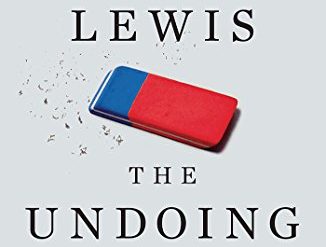
What does government do for us? Do we really need it? What happens if government ceases to do those things? These are the questions Michael Lewis comes to grip with in his powerful little book, The Fifth Risk. By drilling down into the day-to-day realities in a handful of little-recognized federal agencies, Lewis convincingly demonstrates how government protects us from some of “the most alarming risks facing humanity.” By extension, he relates the dangers we (and the world as a whole) now face as the direct result of inattention, greed, and misguided policy by the Trump Administration.
Estimated reading time: 7 minutes
How government protects us
At the outset, Lewis makes the case that “The basic role of government is to keep us safe,” to quote one of the expert government-watchers he interviewed. He points out that “The United States government employ[s] two million people, 70 percent of them one way or another in national security.” As Lewis makes clear at length, that 70 percent doesn’t include just those working in the Pentagon or the Department of Homeland Security. They also toil away in such little-recognized departments as the National Oceanic and Atmospheric Administration, or NOAA.
Clearly, if a hurricane or a tsunami is on the way to your town, you sure want to know about it—and that’s one of the principal functions of the National Weather Service, one of NOAA’s agencies. NOAA supplies ALL the data on which our weather forecasts are based. That includes private entities and individuals such as Accuweather and The Weather Channel. Unsurprisingly, the Trump Administration is trying to cut NOAA’s budget. Just imagine how American business, let alone the American public, would conduct our daily activities if we couldn’t depend on accurate weather forecasts.
The Fifth Risk by Michael Lewis (2018) 221 pages ★★★★★
The Department of Commerce has little to do with commerce
For some obscure reason, NOAA is located in the Department of Commerce. In fact, it turns out that the Department of Commerce has little to do with commerce and trade. As a practical matter, the department is a depository for much of the government’s vast stores of data—not just on the weather but on the census, the economy, patents and trademarks, and many other matters. “The Department of Commerce should really be called the Department of Information,” Lewis writes. This came as a shock to Trump’s new Commerce Secretary, Wilbur Ross, once he learned what the Department actually does. As Lewis makes clear, many of Trump’s other top appointees were in for similar shocks. They came to their jobs completely unprepared, unwilling to learn from the extensive efforts by their predecessors to brief them, and often determined to undermine the work of the new departments in their charge. You’re right to be worried about the consequences.
A “bungled transition” is the root cause of much of the trouble
It’s common knowledge that Donald Trump came to the Oval Office totally unprepared for the job and unwilling to learn what it might entail. In truth, he hadn’t expected to win the election (and may well not have wanted to do so). “His campaign hadn’t even bothered to prepare an acceptance speech,” Lewis reports. But the problems the country (and the world) are now facing as a result run far deeper than Trump’s own lack of preparation. Michael Lewis finds the bigger cause in a “bungled” Presidential Transition.
Trump insisted he didn’t want to form a Transition Team. Somehow, former New Jersey Governor Chris Christie managed to convince him, anyway. Christie assembled a small team beginning months before Election Day. Shortly afterward, he delivered to the President-elect a list of (presumably) qualified people to fill many of the 4,000 top government jobs. Nothing happened. Then, a month later, Christie and his entire team were fired, and the team’s report disappeared. A new Transition Team dominated by Steve Bannon and Trump personally began work from scratch in December, barely a month before the new Administration would assume power. Is it any wonder that the result was chaotic? Should we be surprised that so many of the most senior positions were filled with people who were ill-suited for the jobs they were given?
Interview with a Chief Risk Officer
One of the many former high-level government officials Lewis interviewed was John MacWilliams, who had served as the Chief Risk Officer of the Department of Energy (DOE) late in the Obama years. Like Commerce, DOE is a conglomerate department that encompasses a host of functions no unsuspecting member of the public might guess. “About half its budget in 2016 went to maintaining the nuclear arsenal and protecting Americans from nuclear threats,” Lewis notes. MacWilliams pointed out to him that, in fact, DOE is “‘the place where you could work on the two biggest risks to human existence, nuclear weapons and climate change.'” Lewis asked MacWilliams to identify the “top five risks I need to worry about right away.”
So, what is the “Fifth Risk?”
Accidents with nuclear weapons and climate change top the list of five. They’re the first risk. The second and third are a potential attack by North Korea and the threat that Iran might develop a nuclear weapon now that Trump has pulled out of the Iran treaty. MacWilliams identifies the fourth as the fragility of our electrical grid. What, then, is the Fifth Risk? “‘Project management,'” MacWilliams says. To illustrate, he pointed Lewis to the decommissioned plutonium production facility at Hanford, Washington, which the author toured. There, a local official explained that “‘There are Fukushima-level events that could happen at any time.'” Without competent and attentive management, anything could happen there. We take for granted that our government protects us from such threats. But are we safe to do so under this Administration? Who might be appointed to manage the 200 square miles of nuclear risks at Hanford?
“There is an upside to ignorance”
Lewis notes that “There is another way to think of John MacWilliams’s fifth risk: the risk a society runs when it falls into the habit of responding to long-term risks with short-term solutions.” This is exactly what the Trump Administration hopes to do with Hanford, by cutting its budget—and with so many other government programs. “There is an upside to ignorance, and a downside to knowledge. Knowledge makes life messier. It makes it a bit more difficult for a person who wishes to shrink the world to a worldview.” And isn’t this just exactly what’s going on throughout the federal government under Donald Trump?
Michael Lewis’ “most ambitious and important book”
In reviewing this book for the New York Times Book Review (October 14, 2018), Joe Klein notes that “‘The Fifth Risk’ raises the most important question of the moment: Have we grown too lazy and silly and poorly educated to sustain a working democracy? . . . The federal government exists at a level of complexity most people just can’t be bothered to understand. We have little idea what it does, only the vague sense that it doesn’t do anything very well. Michael Lewis has taken on the task of rectifying that misconception, and he has done so with refreshing clarity—and a measured sense of outrage—which makes this book his most ambitious and important book.”
For related reading
You’ll find this book on The 40 best books of the decade.
Previously I’ve reviewed four other books by Michael Lewis:
- The Undoing Project: A Friendship That Changed Our Minds, reviewed at Michael Lewis on the science of decision-making;
- Flash Boys: A Wall Street Revolt, reviewed at “The stock market is rigged!”;
- Boomerang: Travels in the New Third World, reviewed at What goes around, comes around: following the financial meltdown around the world; and
- The Big Short, reviewed at The clever investors who made fortunes from the Great Recession.
This is one of the 15 books about Donald Trump and his impact on American democracy reviewed on this site. Like to read books about politics and current affairs? Check out Top 10 nonfiction books about politics.
And you can always find my most popular reviews, and the most recent ones, on the Home Page.




























It would be more helpful if you separated your political opinions from what the author actually said in his book. I can’t tell where he left off and you began. It would also be helpful for you to review the pro-conservative/libertarian books that have been written since Trump took office. But I doubt that you’ll read them.
I reserve the right to express my political opinions at any time. In fact, I have read at least two recent books about Donald Trump by conservative commentators. They do not approve of him or of what he is doing to our country.